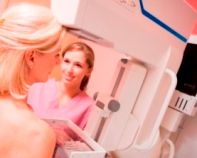Offering Manicures and Massages to Boost Mammogram Screenings
Many practices and hospital imaging departments nationwide are using manicures, wine, massages, and other activities to bring women in for their annual breast screenings. These so-called mammogram parties have received an extremely positive response from patients, officials said.

The last time you performed a mammogram, your patient probably didn’t have freshly manicured nails, and she likely didn’t leave her cocktail outside the exam room door.
But many practices and hospital imaging departments nationwide are using manicures, wine, massages, and other activities to bring women in for their annual breast screenings. These so-called mammogram parties have received an extremely positive response from patients, officials said.
Since March, the diagnostic imaging department at Provena St. Joseph Medical Center in Joliet, Ill., has held a monthly mammogram party. An uptick in scheduled appointments was evident almost immediately.
“These parties have been received really well by both our patients and our technologists,” said Jan Ciccarelli, Provena’s director of marketing and community relations. “For our techs, it’s been great because the women are festive. They’re in a good mood, and it’s a great opportunity to educate them about self-exams and annual testing.”
Along with desserts and drinks, the women receive manicures, pedicures, and chair massages from graduating cosmetology students. These treats are free to the women – they’re only responsible for their normal insurance co-pay. But, Ciccarelli said, these events don’t have to cost you much either. Partnering with your hospital’s chefs and spa professionals who will volunteer their time can keep these events from impacting your bottom line.
In addition to infusing fun into the mammogram experience, technologists with Via Christi Clinic in Wichita, Kan., discovered they’re reaching women who have neglected being screened for several years. The trick, they said, is having the parties after normal business hours.
“We survey the women at the end, and we’ve found we’re capturing women who weren’t scheduling their mammograms because they couldn’t get time off work or couldn’t work the scan into their daily schedule,” said Kristi Fenwick, Via Christi Clinic’s physician marketing and services coordinator, adding that their parties also include chocolate fondue and paraffin wax hand dips.
However, throwing a mammogram party requires more preparation than simply choosing hors d’oeuvres and planning pampering treatments. There are a few strategic points you should remember if you choose to offer this option to your patients, Ciccarelli said. Only invite employees from your clinic or hospital to the first party. Consider it a dry run to identify and fix any kinks in the system.
Also, make sure to get proper buy-in from your technologists.
“Make sure your techs are onboard because the parties will likely be scheduled outside of their normal work hours,” she said. “You might find that they’re so glad to have the teaching opportunity that they’re more than happy to work after hours.”
There is a potential stumbling block, however. Many insurance plans require patients to have a physician order for a mammogram. To work around this mandate, Provena established an agreement with several of its primary care physicians who agreed to take on as a patient any woman who receives a breast cancer diagnosis.
Emerging AI Algorithm Shows Promise for Abbreviated Breast MRI in Multicenter Study
April 25th 2025An artificial intelligence algorithm for dynamic contrast-enhanced breast MRI offered a 93.9 percent AUC for breast cancer detection, and a 92.3 percent sensitivity in BI-RADS 3 cases, according to new research presented at the Society for Breast Imaging (SBI) conference.
The Reading Room Podcast: Current Perspectives on the Updated Appropriate Use Criteria for Brain PET
March 18th 2025In a new podcast, Satoshi Minoshima, M.D., Ph.D., and James Williams, Ph.D., share their insights on the recently updated appropriate use criteria for amyloid PET and tau PET in patients with mild cognitive impairment.
Can Abbreviated Breast MRI Have an Impact in Assessing Post-Neoadjuvant Chemotherapy Response?
April 24th 2025New research presented at the Society for Breast Imaging (SBI) conference suggests that abbreviated MRI is comparable to full MRI in assessing pathologic complete response to neoadjuvant chemotherapy for breast cancer.
Clarius Mobile Health Unveils Anterior Knee Feature for Handheld Ultrasound
April 23rd 2025The T-Mode Anterior Knee feature reportedly offers a combination of automated segmentation and real-time conversion of grayscale ultrasound images into color-coded visuals that bolster understanding for novice ultrasound users.